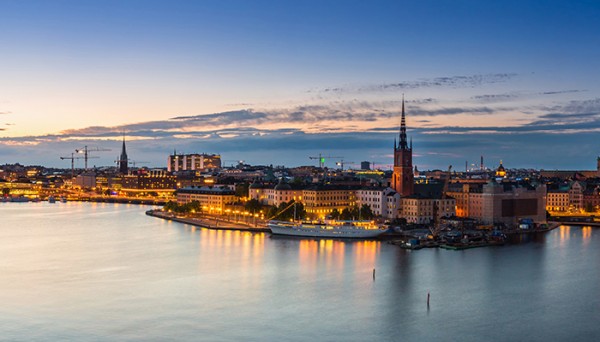Driven by strict legislation and enforcement measures, on one side, and the challenge of pricing, on another, manufacturers of HVACR equipment in Scandinavia have relied on innovation to survive… and to thrive. Internationally, they are benefitting from the strict regime and the exertions it has engendered.

Scandinavia
It is believed that whenever Europe needs some vision or perspective, it follows Scandinavia by example. The countries to the north have managed to create a welfare system with free education, public support initiatives and a mature public health service. Scandinavian countries top the international rankings of the most competitive regions in the world, despite their having some of the highest taxes in the world, and despite their workers working fewer hours than those from other countries. Moreover, Scandinavian nationalities are some of the world’s happiest, according to the World Happiness Report.

Kim Valbum, CEO of Refrigeration, Air Conditioning and Heat Pump Contractors, Denmark
The region’s best practices also extend to the HVACR sector, driven by a strong sustainability ethos, among other factors. “The HVACR industry in Scandinavia is working seriously to solve a number of environmental and energy challenges, and to meet EU and national demands for low-energy consumption, low-environmental impact and low-noise levels,” says Kim Valbum, CEO of Refrigeration, Air Conditioning and Heat Pump Contractors, Denmark. Commenting on the market size, he adds that the HVACR market in Scandinavia – including Denmark, Finland, Norway and Sweden – is estimated to be USD 5 billion annually.
Demand drivers

Sune Boesen, Key Account Manager, Export, at Lindab Group
“What is driving the market right now is the transition from traditional energy sources to sustainable energy, and the efforts to reduce energy consumption, as much as possible,” Valbum says. Sune Boesen, Key Account Manager, Export, at Lindab Group, agrees with Valbum that energy efficiency is one of the key drivers. In his view, companies like Lindab, Swegon, TROX/Auranor, Fläkt Woods and Halton are striving to supply the newest and most energy-conscious solutions to the market.

Hans Ole Matthiesen, Global Segment Director at Danfoss
Apart from energy efficiency, the drivers include legislation and regulations, especially when it comes to refrigerants, reveals Hans Ole Matthiesen, Global Segment Director at Danfoss. “Refrigerant legislation,” he says, “has been a concern for the last many years – for example, the phasing out of HFCs, followed by the EU F-Gas Regulations [see ‘Join the ban-wagon’]. These regulations are impacting all equipment manufacturers in the industry.” Danfoss, Matthiesen adds, plays an important role as a supplier of equipment aligned to low-GWP (global warming potential) alternatives like ammonia, CO2 and the new HFO refrigerants.
Price is also a driver, or rather a challenge, in the HVACR sector, Boesen says. “The Scandinavian market is a fairly high-priced market, so our challenge is to compete with cheaper and, usually, lower-quality products.” The best way to cope with this is to give customers the added value by providing solutions and other after-sales support, he adds.
I know that here in Copenhagen, around 200MW of District Cooling can be delivered. As we use seawater for the cooling process, we expect over the next few years to save around 79,000 tonnes of CO2/year, as District Cooling reaches all across Copenhagen, when compared to electricity used for cooling
Yet another way to cope with the challenge of pricing is through innovation, Boesen says.
Regulations force innovations
Matthiesen says that most of the innovations in Scandinavia are owing to governmental regulations. “Advansor, a rack/pack supplier OEM, started their business less than 10 years ago, aiming to supply systems to the local market due to strict regulations on the use of refrigerants,” he says, by way of sharing an example. “In Denmark, GWP-based refrigerant taxation and limits on HFC refrigerant charges forced this development. Today, Advansor is among the largest rack manufacturers in Europe. There are a number of other companies in Scandinavia that have experienced similar international success as a result of harsh local legislation.”
[div class=”text-box text-box-left”]
Hans Ole Matthiesen, Global Segment Director at Danfoss. says that refrigeration, both for industrial and commercial purposes, constitute the main market within the HVACR segments in Scandinavia, with equipment manufacturers such as Johnson Controls (Sabroe), Norpe, Arneg (Wica), Hill Phoenix (Advansor), Hoshizaki (Gram Commercial) and Vestfrost, being the major players. He adds that refrigeration systems not only in Scandinavia but worldwide are becoming an integrated part of the distributed District Heating network. “This means that supermarkets with large refrigeration systems or, in principle, all facilities having large refrigeration systems, are not only consumers of energy but also suppliers of energy,” Matthiesen reveals. “Until only a few years ago, the big news was that you could utilise the heat in refrigeration systems to heat supermarkets. Today, this technology is applied in most new supermarkets, and now, the very same supermarkets, can also supply heat to private homes, which are located nearby.”
[end-div]
There are more such examples of Scandinavian manufacturers rising to the occasion with innovative products, in the face of tight legislation. Elaborating on what he had said earlier, Matthiesen speaks of the TG310 compressor, which Danfoss recently introduced. He says that it uses the ultra-low-GWP refrigerant, HFO-1234ze (E), which he claims, makes it a highly energy-efficient and environmentally progressive compressor.
Boesen says that Scandinavian companies have always been seen as innovative and quality-oriented when it came to the building process. Lindab, for instance, he says, is always looking to roll out new solutions – one of them being the company’s next-generation VAV (Variable Air Volume) system – and striving to innovate, by keeping energy savings and quality as important criteria.
Matthiesen remarks that the cooling industry has always focused on new technologies, new industries and new synergies. Besides the contemporary cooling approaches, he adds that District Cooling and District Heating have also always been on the radar.
At the frontier of District Energy
In 2013, Pernille M Overbye, Market Manager and Head of Department, District Energy, Ramböll, spoke of how 62% of all households in Denmark are supplied by District Heating, in an article titled “Two Case Studies – Planning for District Cooling”, published in Hot|Cool, in 2013. “The expertise we have developed both in Denmark and from around the world within District Heating is also wanted within District Cooling, as countries around the world look to District Cooling as part of a small energy infrastructure,” she said in the article.
[div class=”text-box text-box-right”]
Regulation in Denmark has led to a decline in the use of F-gases. The import of bulk HFC substances has been reduced from around 1,000 tonnes a year, in 2000, to around 350 tonnes, in 2010. In 2001 and 2002, Denmark introduced national regulation on F-gases. The aim was to reduce the use and emission of F-gases, and the Danish Parliament (Folketinget) agreed on a number of instruments. They introduced a ban on the use of F-gases for certain purposes, F-gas taxation and support for research and development of alternative technology.
In Denmark, taxation was implemented in 2001, and a ban on certain applications was introduced in 2002. (Information source: www.unep.org. Low GWP Alternatives to HFCs in Refrigeration, Environmental Projekt no. 1425)
[end-div]
Matthiesen says with certainty that in the Scandinavian region, District Cooling is mainly in the form of circulating seawater to buildings from small District Cooling circuits. “Large consulting companies, like Ramböll and COWI, are working with District Cooling systems. Due to the Scandinavian climate, we do not have a lot of cooling of older buildings.”
However, the demand and future for District Cooling still persists, Boesen says. “I know that here in Copenhagen, around 200MW of District Cooling can be delivered. As we use seawater for the cooling process, we expect over the next few years to save around 79,000 tonnes of CO2/year, as District Cooling reaches all across Copenhagen, when compared to electricity used for cooling [article source: http://ing.dk/artikel/koebenhavn-aabner-fjernkoeling-i-sydhavnen-nordhavnen-og-oerestad-168847],” Boesen says. “As the market demand for cooling increases, so will District Cooling.”
Transferring knowledge
With its experience and knowledge in the District Energy infrastructure systems and HVACR equipment, Scandinavia has always been a region of interest for GCC counterparts, Matthiesen says, adding that its HVACR products have found favour with regional distributors, contractors and developers. “The local air-conditioning OEMs and contractors in the GCC region heavily rely on the components designed and manufactured in Scandinavia,” he says. “The same is applicable for the refrigeration segment.”
Boesen adds that some Gulf countries follow American standards while some follow British, which can be a challenge for Scandinavian producers. However, he remarks, market penetration is already underway. “As long as we have designers from the UK and Scandinavia, we will succeed in transferring our solutions to the GCC.”
Copyright © 2006-2025 - CPI Industry. All rights reserved.